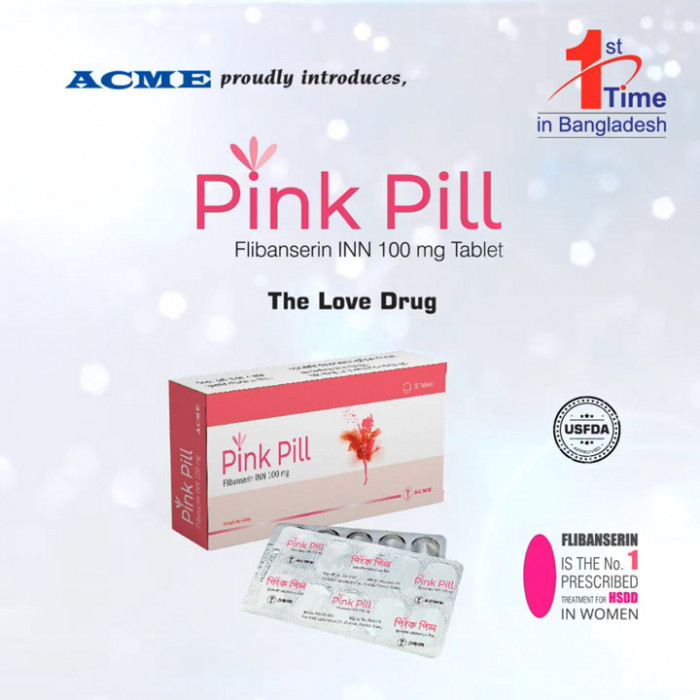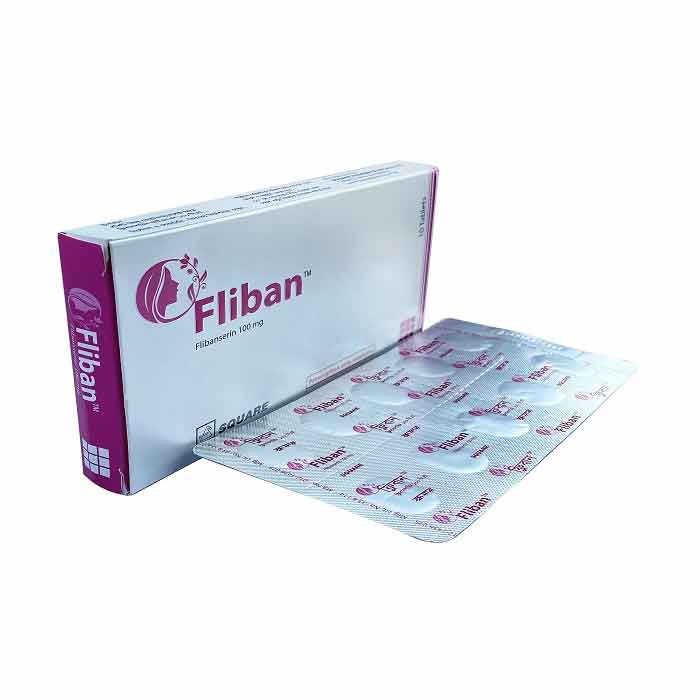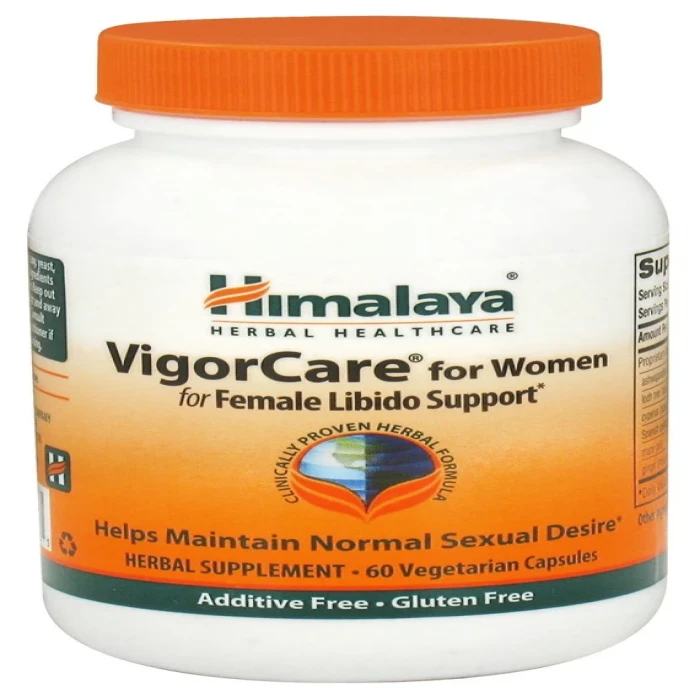

✔ 100% Authentic Product
👁️ Currently Viewing 16332
Pink Pill 100mg Tablet
Flibanserin is a prescription drug indicated for the treatment of premenopausal women with acquired, generalized hypoactive sexual desire disorder (HSDD), as characterized by low sexual desire that causes marked distress or interpersonal difficulty.
Discount
Price: ৳ 465
MRP:
৳
500
7%
Off
✅ Description:
Pink Pill 100 is a medication used to treat hypoactive sexual desire disorder (HSDD) in premenopausal women. It is specifically indicated for women who have not experienced low sexual desire in the past and whose low sexual desire is not caused by medical or psychiatric conditions, relationship issues, or the use of certain medications.
It's important to note that flibanserin is not intended for use by men or women who have already gone through menopause. The medication is available only through a special program, and patients must be registered in the program and have a clear understanding of the potential risks and benefits associated with its use.
If you are experiencing low sexual desire and are interested in exploring treatment options, it is recommended to consult with a healthcare professional who can assess your specific situation and provide appropriate guidance and recommendations. They will be able to determine if flibanserin or any other treatments are suitable for you.
✔️ Uses of Pink Pill 100
- Treat Low Sexual Desire in Woman
✔️ How does Pink Pill 100 work?
Pink Pill 100 works by targeting and balancing certain neurotransmitters in the brain, specifically dopamine and norepinephrine, which play a role in sexual desire.
✔️ Side Effects of Pink Pill 100
Common side effects of flibanserin include:
- abdominal pain
- abnormal bleeding from the uterus
- anxiety
- central nervous system depression
- constipation
- dizziness
- dry mouth
- fainting
- fatigue
- insomnia
- low blood pressure
- nausea
- rash
- sedation
- sleepiness
- spinning sensation (vertigo)
✔️ Quick Suggestions:
- It is important to avoid drinking alcohol while taking flibanserin. Alcohol can increase the risk of side effects such as low blood pressure, dizziness, and fainting. It is advisable to refrain from consuming alcohol during treatment with flibanserin.
- Flibanserin is metabolized by the CYP3A4 enzyme in the liver. Co-administration with moderate or strong CYP3A4 inhibitors can increase the levels of flibanserin in the body, leading to a higher risk of side effects. If you are taking any medications that are known as CYP3A4 inhibitors, it is important to inform your doctor, who can adjust the dosage of flibanserin if necessary.
- Flibanserin should be used with caution in patients with any degree of hepatic impairment. The medication is primarily metabolized in the liver, and impaired liver function may affect the clearance of flibanserin from the body.
- Your doctor will evaluate your liver function and may adjust the dosage of flibanserin accordingly or suggest an alternative treatment option if needed.
✔️ Indication of Pink Pill 100
A prescription medication called flibanserin is used to treat premenopausal women who have acquired, generalized hypoactive sexual desire disorder (HSDD), which is characterized by low sexual desire that significantly affects their quality of life or interpersonal relationships.
✔️ Pharmacology
Dopamine D(4k), serotonin 5-HT(1A), and serotonin 5-HT(2A) receptors are where flibanserin has a preferential affinity. Flibanserin acts as a 5-HT(1A) agonist, a very weak partial agonist on dopamine D(4) receptors, and a 5-HT(2A) antagonist in vitro and during micro iontophoresis. Flibanserin binds to 5-HT(1A) and 5-HT(2A) receptors equally in vivo. Flibanserin, however, may occupy 5-HT(2A) receptors in a higher proportion than 5-HT(1A) receptors when brain 5-HT levels are higher (i.e., under stress). Flibanserin differs from the claimed 5-HT(1A) receptor agonists buspirone and 8-OH-DPAT in how it affects adenylyl cyclase. The CA1 region of the brain is the most sensitive to flibanserin's effects, which include a decrease in neuronal firing rate in cells of the dorsal raphe, hippocampus, and cortex. The stimulation of postsynaptic 5-HT(1A) receptors appears to be the mechanism by which flibanserin reduces the firing rate in the cortex, whereas the stimulation of dopamine D(4) receptors appears to be the mechanism by which flibanserin reduces the number of active cells. Flibanserin increases tonic activation of postsynaptic 5-HT(1A) receptors in the CA3 area while rapidly desensitizing somatic 5-HT autoreceptors in the dorsal raphe. In the cortex, flibanserin preferentially decreases 5-HT production and extracellular levels while increasing NE and DA extracellular levels. In the majority of animal models that are susceptible to antidepressants, flibanserin exhibits antidepressant-like effects. However, this activity appears to be of a higher caliber than that produced by conventional antidepressants. In those animal models, flibanserin appears to function by either directly or indirectly stimulating the 5-HT(1A), DA, and opioid receptors. In animal models of anxiety, flibanserin does not consistently affect the animals, but it does appear to have antipsychotic potential. At pharmacologically significant concentrations, flibanserin may cause mild drowsiness but does not cause detectable toxic consequences.
✔️ Dosage & Administration of Pink Pill 100
Dosage & Administration:
- Recommended for premenopausal women with acquired, generalized hypoactive sexual desire disorder (HSDD), which is characterized by low sexual desire that causes noticeable distress or interpersonal difficulty and is not brought on by a concurrent medical or mental health condition, relationship issues, the side effects of a medication, or any other drug substance
- 100 milligrams taken orally once daily before bed
administered during bedtime due to increased risks of central nervous system depression, syncope, hypotension, and accident during administration during waking hours - If no improvement after 8 weeks, stop the medicine.
Untaken Dosage:
- Instruct the patient to take the subsequent dose at bedtime the next day if a dose is missed at bedtime.
- Give the patient instructions not to double the next dose
✔️ Interaction
- If your physician has prescribed this medication for you, he or she may already be aware of any potential drug interactions and may be keeping an eye out for them. Never begin, stop, or alter the dosage of any medication without first consulting your doctor, healthcare provider, or pharmacist.
- 57 distinct medicines and flibanserin interact badly.
Venetoclax is among the serious interactions of flibanserin.
Moderate interactions exist between 202 different medications and flibanserin. - Minor interactions between flibanserin and other medications are unknown.
- The interactions and negative effects mentioned here are not all possible. Therefore, inform your doctor or pharmacist of all the products you use prior to using this medicine.
- Keep a list of all the medications you are taking with you, and let your doctor and pharmacist know about it. If you need additional medical advice, have questions about your health, or concerns, or would like more details about this medication, speak with your doctor or another qualified healthcare provider.
- To avoid the interactions, it is said to not mix Flibanserin 100mg Tablets with any other medications. Some drugs which can interact with the tablets are:
- Calcium Channel Blockers
- Fluconazole
- Ketoconazole
- Macrolide Antibiotics
- Rifampicin
- Carbamazepine
- Nefazodone
- Phenytoin
✔️ Contraindications
- Use with alcohol
- Coadministration with moderate or strong CYP3A4 inhibitors
- Any degree of liver impairment
✔️ Pregnancy & Lactation
There are no studies on pregnant women to inform whether there is a drug-associated risk in humans. Unknown if distributed in human breast milk and it is unknown whether flibanserin has effects on the breastfed infant or if it affects milk production.
✔️ Precautions & Warnings
- YP3A4 inhibitors can increase the risk of severe hypotension, syncope, and CNS depression. It is important to avoid alcohol and inform your doctor about any medications or herbal supplements you are taking, as they may interact with flibanserin.
- Regarding lactation, there is limited information available about the distribution of flibanserin in human breast milk. Flibanserin has been found to be excreted in rat milk. Due to the potential for serious adverse reactions, including sedation, in a breastfed infant, breastfeeding is not recommended while undergoing treatment with flibanserin.
- It is crucial to follow the guidance provided by your healthcare provider regarding the use of flibanserin, including avoiding alcohol, informing them about any other medications or herbal supplements, and refraining from breastfeeding during treatment. They will be able to provide you with personalized advice and monitor your treatment to ensure your safety and well-being.
✔️ Storage Conditions
Keep in a dry place away from light and heat. Keep out of the reach of children.
⚠️Disclaimer:
At ePharma, we’re committed to providing accurate and accessible health information. However, all content is intended for informational purposes only and should not replace medical advice from a qualified physician. Please consult your healthcare provider for personalized guidance. We aim to support, not substitute, the doctor-patient relationship.








